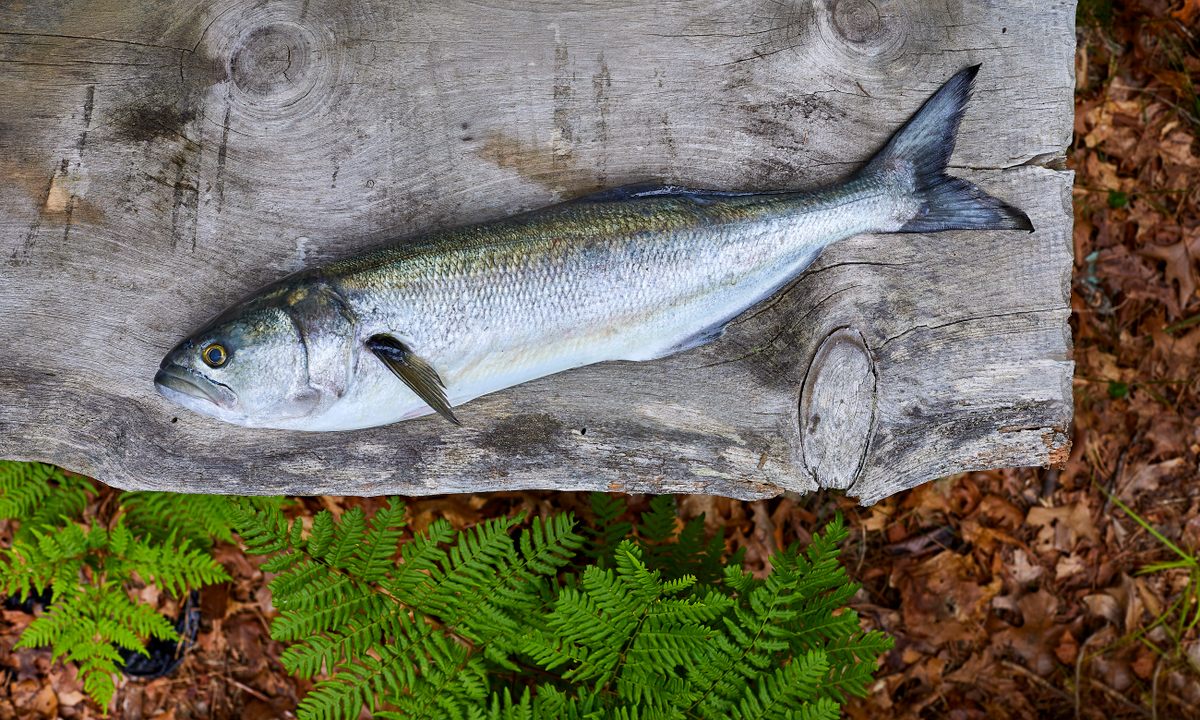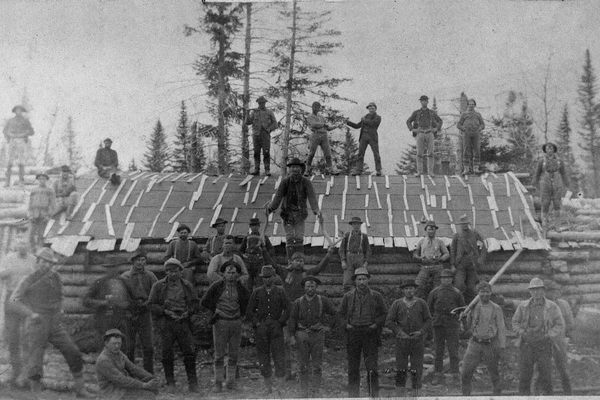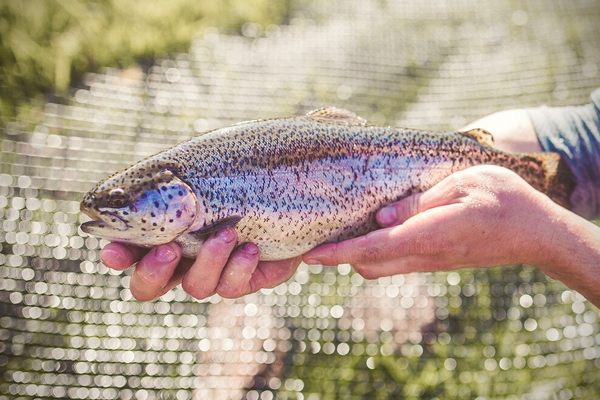The 19th-Century Recipe That Created a Fish-Cookout Craze
Recreate the heyday of shad bakes with this plank-roasting technique.
Gastro Obscura’s Summer Cookout columnist Paula Marcoux is a food historian and the author of Cooking With Fire: From Roasting on a Spit to Baking in a Tannur, Rediscovered Techniques and Recipes That Capture the Flavors of Wood-Fired Cooking. Throughout the summer, she’ll be sharing recipes and stories from the luminous history of open-fire cooking.
For centuries, the shad inhabited the American imagination at the intersection of bountiful lusciousness and democratic access. Untold millions of good-sized, richly-flavored fish would fan out to every estuary from Florida to Maine each spring, pushing from unknown winter quarters in the Atlantic all the way to the headwaters of rivers, large and small. Their progress delivered a boon of notably delicious protein to predators from the edge of the sea to the first impassable waterfall. Indigenous people, then European colonizers, then Americans of all backgrounds netted in massive hauls of the spawning fish, cooking and eating them in their households, bringing them to market, or preserving them for later use or sale.
More esteemed than common herring and alewife, more widespread than salmon and sturgeon, the American shad reigned supreme among anadromous fish during its seasonal visit. Coastal communities shifted priorities during the run, putting aside farm work to make the most of the annual windfall or temporarily moving entire households to the shore to work the shad nets.
As far back as the days of the early Republic, riverside taverns and inns were thronged as the fishing population swelled with the annual arrival of the shad. Gawkers and hangers-on came to enjoy the festival atmosphere, watch other people work, and eat shad and drink. It’s at this juncture that cooking shad on a plank probably caught on as a convenient way to put the fish-windfall to work and to profit from the crowds of hungry visitors. Its novelty—and the tastiness of the result—made an impression on visitors, generation after generation.

Strikingly, one of the better descriptions of a mid-19th-century shad-planking event depicts the participants, who happened to be U.S. senators and congressmen, deeply involved in the production of the meal. An 1884 article from The Magazine of American History with Notes and Queries reflects on the seasonal tradition of politicians journeying down the Potomac on a steamboat to dine on planked shad. The festive atmosphere was marked by storytelling, card-playing, and the boat’s “large demijohns filled with the best wines and liquors, which almost everybody drank without stint.”
The article notes that when they arrived at the White House fishing grounds, some of the men couldn’t help but roll up their sleeves to get involved, as “some would go on shore, some would watch the drawing of the seine from the boat, [and] some would take charge of the culinary department.” Shortly after arrival, freshly caught shad would be “scaled, split open down the back, cleaned, washed and dried,” then nailed to a two-foot-long oak plank that had been “scalded and wiped dry.” The plank was then placed at an angle near a hot wood fire, basted occasionally with a mixture of butter and flour, and “baked until it was a rich dark brown color.”
Storied politician Daniel Webster is depicted as showing off his cooking prowess in tales from not one, but two, distinct Potomac excursions. One of these stories involves a jovial shad-planking competition with an enslaved man known as Old Sam, offering a rare glimpse of the expertise and makeup of the crew actually putting on the event.
The D.C. power-brokers’ rough-and-ready approach to shad-planking would give way to a far more genteel vibe, suitable for diners who didn’t want to get their hands dirty. A minor seasonal industry—embraced by subsequent generations of Supreme Court justices, professional conference groups, adventurous tourists, and urban holiday-makers—grew up.
Impresarios organized slick package tours culminating in “shad-bakes” staged at sites just a bend in the river away from major cities like Philadelphia (Gloucester City, New Jersey) and Washington (Marshall Hall, Maryland). Boarding a steamship at a convenient urban pier, guests would be entertained with band music or magic tricks while enjoying the easy trip down and across the slow river. They would pause to view the picturesque and instructive shad-fishing operation in full swing, then arrive at the picnic grounds in time to see the visually striking cooking operation—hundreds of shad roasting by oak fires—before being ushered to dining tables where the hot planks would be laid before them to enjoy. Depending on the inclination of the group, ample booze would be available from departure through return, or not.

By the end of the Civil War, though, it became clear that the shad was in trouble; inquiries were launched by the federal government. Scientists identified a constellation of problems with one overarching cause: Industrializing America, with its multiplying dams and mills, sewage-emitting population centers, and ubiquitous clearcutting and agriculture, had poisoned, clogged, and shoaled the rivers from Massachusetts to Virginia.
This dismal situation would only grow worse with the development of the turbine-driven generator, ushering in the electrification era. The 1880s alone saw the building of hundreds of hydroelectric dams across U.S. rivers, effectively closing off the shad from their already diminished spawning grounds. At first, shad still arrived in vast numbers, milling around at the foot of new dams until exhausted. For a spring or two, these wandering, mystified fish were an easy boon to local fishers; thereafter, shad numbers in the estuary would nearly collapse.
Fixes that worked for other anadromous fish, like channels and ladders designed to allow passage around a dam, were a failure for the shad, which were thought too “timid” to use them. The government invested in large-scale breeding programs, collecting eggs and raising shad fry in hatcheries, with limited success.
Where fish still returned to spawn, concentrated in the coastal estuaries below dams, the industry was flipped on its head. As the fishing itself became industrialized, profits aggregated to wealthy investors. Vast capital was required to pay staggering sums for nets two miles in length, steam launches and gunpowder for setting the far end of the netting, and power-winches for hauling them in full of shad.

Gangs of men still found employment but gone were the days of equal-opportunity subsistence and local market fishing. No longer would thousands of riverside communities up and down the Eastern Seaboard experience the springtime explosion of food and profit, available to anyone with a simple net.
Today’s shad population is studied, managed, and sometimes augmented by federal and state agencies throughout the East Coast; a few rivers even host sufficient numbers of spawning fish to support a little sport-fishing from time to time. The habitat challenges the fish faced in the 19th century largely remain, but with climate and sea-level instabilities piled on.
The best news for shad, though, is in the form of river restoration projects springing from partnerships among local nonprofits, universities, and government agencies. Multi-pronged and targeted campaigns, often involving armies of volunteer citizen scientists counting and tagging spawning fish, have contributed the data needed to back up scores of dam removal projects. In rivers that have been cleared of barriers and where clean water initiatives of the late decades have been effective, fish can be reintroduced. The work is ongoing: In Massachusetts, fish biologists even dream of restoring an urban sport-fishing run up Boston’s Charles River.
The good news for us, as cooks and eaters, is that the fabulous planking technique can be applied to other fish. With proper planning and the right tools and materials, the adventurous outdoor cook can recreate the delectable entertainment of a 19-century shad bake.

How to Plank a Fish
Plank-roasting was a convenient commercial method that created memorably delicious results and was a lot of fun for diners. Though the technique was inextricably linked with shad in 19th-century America, it’s helpful to decouple the two, I find, as a cook and eater. On the one hand, you needn’t wait around until you find a shad to start planking, and on the other, if you do get a shad, and it’s raining out, you should feel empowered to cook it in another delicious way.
Nineteenth-century cookbooks and periodicals make it clear that, stuffed and baked, or broiled over coals, shad was welcome at tables rich and poor, rural and urban, North and South—appropriate for breakfast, mid-day dinner, or supper. Cooks floured and fried shad roe, or scrambled it with hen’s eggs. Fishing families pressed and salted roe for a high-protein, shelf-stable snack, and used salted shad in place of salt pork when that ran out.
Another piece of good news is that if you would like to explore the world of fish-planking, you do not need to wait around for a shad to swim up. The planking technique yields such wonderful results that it pays the cook to investigate other—sustainable, local—options. Look into the species available in your nearest waterway for suitable candidates. If you don’t fish yourself, it’s a great opportunity to ask those who do, or a trusty fishmonger.
The fish
In selecting a planking fish, bear in mind a few important characteristics. Ideally, the fish should be rich-flavored and sturdy, but not tough, in texture. In our New England waters, striped bass and bluefish are terrific summertime options.
Depending upon size, the fish may be planked as filets or simply cleaned and split. Either way it must be scaled, but skin-on; once prepped for the plank, it should flatten to a thickness between ¾ inch and 1½ inches.
The plank
Period descriptions differ on details of the plank’s requirements: Must one scour it well or never clean it? Ought it be new-sawn or used a hundred times? But sources agree on the basic facts-—the plank must above all be hardwood (oak, hickory, and birch are all mentioned) with specific dimensions, i.e., thick (3 inches is not too much) and large enough to hold the fish comfortably, but small enough to pick up and manipulate frequently when extremely hot.
A thick cherry plank, now pleasingly scorched about the edges, has served me well for years.
The nails
Use stainless steel or wrought iron nails with decent-sized heads, just a bit longer than your fish is thick. Never use galvanized nails. Have 8–10 nails on hand per fish.
That article in The Magazine of American History with Notes and Queries references a method using“iron pump-tacks,” a fastening designed to securely hold leather onto wooden pump casings, in service of the high-demand job of a ship’s bilge pumping. This makes sense, as the large heads would not be liable to tear out of the fish skin and iron would not react to acidic ingredients like vinegar and lemon as brass nails would.
Fire arrangement
Before you start the fire, mock up how you will very securely position that plank so that it stands upright and even leans inward toward the fire a few degrees. This inward angle toward the coalbed is advantageous for easy roasting, but not all fish are up to holding up their own weight fastened by a little bit of skin. So it behooves the cook to watch carefully and if gravity is proving too much, just reduce the angle as much as needed to create a more secure situation.
In most circumstances, I trust piles of bricks to angle foods toward heat, but in this case, I recommend driving a few short stakes into the ground at the proper angles, in front and behind the plank, as props and guides so there will be no slip-ups. The stakes behind the plank increase the stability of the whole arrangement and even make a handy place to rest the plank while basting and turning.
You want good, dry hardwood, preferably split fairly small, for your fire.
You will appreciate good heat-resistant gloves when manipulating the hot plank. And don’t forget a claw hammer, a small skillet, and a basting brush. You won’t need a serving platter, just one fork per diner, as you’ll want to just scarf this off the plank.
Ingredients
1 large sturdy skin-on-but-scaled fish filet (2–3 pounds) OR 1 whole fish (about 5 pounds), scaled, gutted, and wiped dry
2 ounces (4 tablespoons) butter, melted
½ teaspoon kosher or sea salt
½ teaspoon cayenne or freshly-ground black pepper
Technique
1. Make a good hardwood fire on level ground or in a slight depression. Develop a nice bed of coals before you start and have plenty of small hardwood chunks standing by.
2. If using a whole fish, behead it and split it carefully to splay and flatten. If using filets, inspect them for bones and use tweezers to extract any you find.
3. Brush the fish all over with melted butter and season liberally with salt and cayenne or black pepper. Set it aside on a tray while you preheat the plank for 10 minutes.
4. Prop the empty plank close to the fire. As it preheats, ascertain that the angle and security of the operation look all right. When the plank is heated “to the point of ignition” as one period description has it (just look for some smoking around the edges), pick it up with gloves and convey it to a solid heat-proof surface.

5. Working quickly, arrange the fish, skin-side down, on the searing-hot plank. Securely nail the perimeter of the flattened fish in place. Remembering that you will be turning the board top for bottom at least once, so test your fastening arrangement against the rigors of gravity. A very large whole fish may warrant a few nails along the spine.
6. Return the board to the fire setup, trying for a little inward lean if the fish will allow. Rake hot coals toward the fish, and feed the back of the fire with small hardwood if needed.
7. Take up the plank and brush the fish with butter every five minutes or so; overturn the plank when you return it to the fire so the fish gets a good even roasting. Feel free to turn and baste as often as you like; period sources make this process seem nearly continual.
8. Test for doneness by prodding the thickest part with a small knife. The fish should be a lovely brown.
9. Return the plank to the solid heat-proof surface to draw out the very hot nails with the hammer. Serve immediately.
Serving suggestions
Period writers variously suggest celebratory seasonal vegetables like asparagus, peas, and new potatoes; compound butters with horseradish or parsley and lemon; and, most beguilingly, “sweet and Irish potatoes … roasted in the ashes … each person having a plank and picking out what portions he liked best, breaking up his roast potato on the warm shad.”
Gastro Obscura covers the world’s most wondrous food and drink.
Sign up for our email, delivered twice a week.




















Follow us on Twitter to get the latest on the world's hidden wonders.
Like us on Facebook to get the latest on the world's hidden wonders.
Follow us on Twitter Like us on Facebook